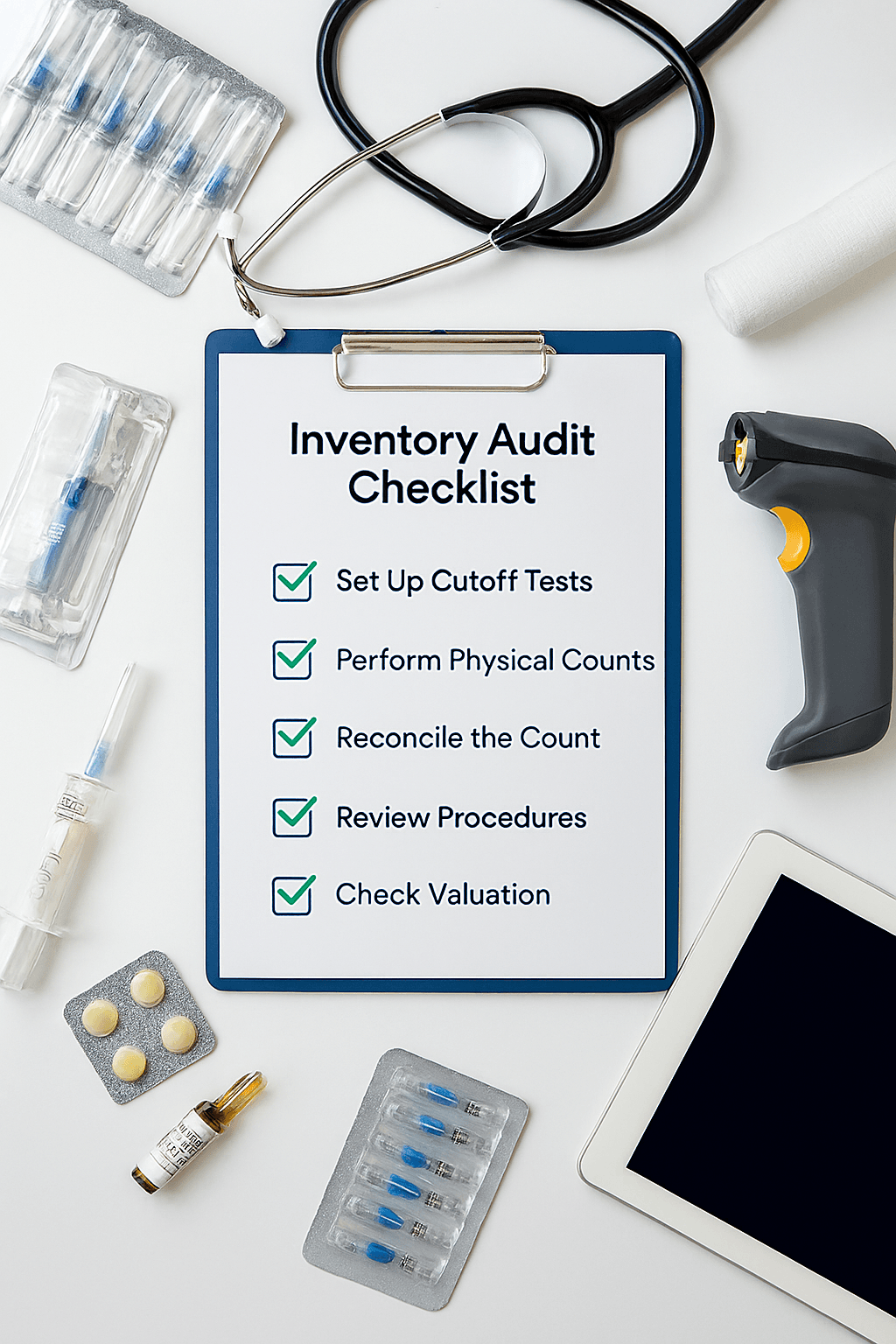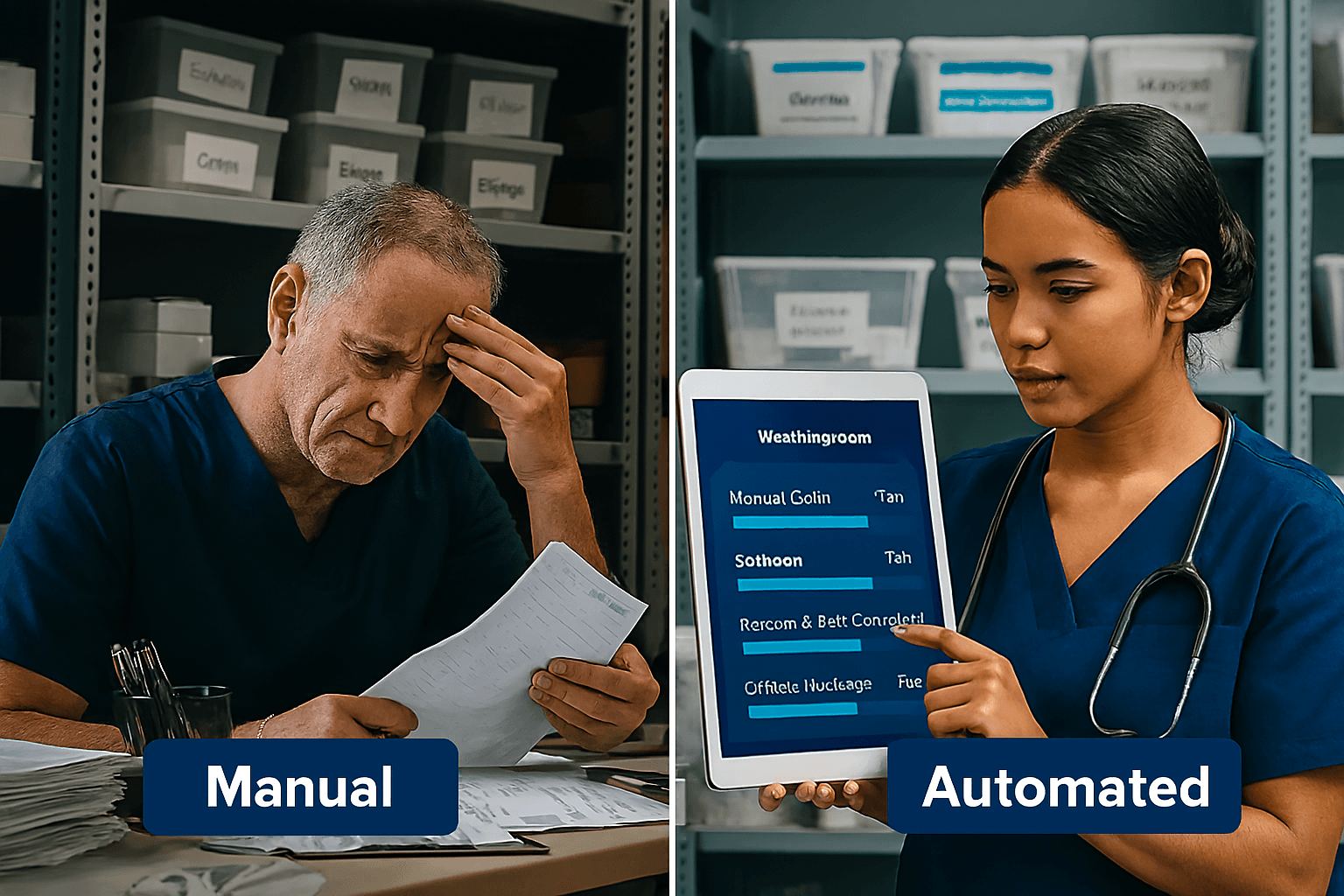

October 24, 2025 | By Stockount

Hospitals rely on a vast array of medical supplies, equipment, and pharmaceuticals to provide quality patient care. Effective inventory auditing ensures that essential items are available when needed, prevents wastage, and maintains regulatory compliance.
An accurate and well-managed inventory not only improves operational efficiency but also directly impacts patient safety. Leveraging inventory audit procedures, modern inventory audit software, and regular physical inventory audits is crucial for hospitals aiming to optimize their supply chain.
The healthcare inventory management market is evolving rapidly, driven by digital transformation and rising demand for cost efficiency.
The global hospital inventory management software market is projected to grow at over 7–9% CAGR through 2030, driven by increased adoption of cloud-based inventory systems and automation.
Hospitals are investing in barcode, RFID, and AI-based inventory solutions to minimize manual errors and improve real-time tracking.
Stricter healthcare compliance (FDA, WHO, and local health authorities) pushes hospitals to adopt transparent audit trails and data-driven systems.
The COVID-19 pandemic exposed supply chain vulnerabilities—now, 80% of hospitals report strengthening their inventory audit processes to ensure resilience against disruptions.
Software such as Stockount, Oracle, Netsuite, SAP, and Smartsheet dominate the hospital audit automation space.
This growing market emphasizes the need for hospitals to modernize their audit systems to stay compliant, efficient, and patient-focused.
Conducting regular inventory control audits is essential in hospital settings due to several reasons:
Ensuring Inventory Accuracy Regular physical inventory audits compare actual stock with recorded data, helping identify discrepancies and correct them promptly.
Regulatory Compliance Hospitals must adhere to strict laws regarding controlled substances and medical supplies. Inventory audits help maintain compliance and avoid legal penalties.
Preventing Stockouts and Overstocking Accurate inventory ensures critical items are always available while preventing overstocking of low-demand supplies.
Cost Management Monitoring inventory usage and conducting stock reconciliation can identify obsolete or slow-moving items, reducing unnecessary costs.

A well-structured inventory audit procedure ensures accuracy and efficiency. Some key steps include:
1. Physical Inventory Audit Counting items physically in storage and comparing them with recorded quantities. Hospitals can use barcode scanners and mobile inventory apps for inventory accuracy.
2. Inventory Reconciliation After counting, discrepancies between actual stock and records are investigated. Using stock reconciliation software simplifies this process by automatically flagging inconsistencies.
3. Cutoff Analysis This ensures all transactions are recorded in the correct period, preventing errors in financial reporting.
4. ABC Analysis Items are categorized based on usage and value:
Prioritizing warehouse audits for A-items ensures critical supplies are always available.
5. Expiry and Safety Checks Perishable items and medications must be monitored carefully. A structured inventory audit checklist helps track expiry dates and safety compliance.
Despite technological advancements, hospitals continue to face several critical challenges that affect inventory accuracy and audit efficiency:

Manual and Fragmented Processes
Many hospitals still rely on spreadsheets or outdated systems, leading to human errors, duplication, and poor visibility.
Lack of Real-Time Tracking
Without integrated audit software, staff can’t monitor usage trends or stock levels in real time, causing delays in replenishment.
Complex Regulatory Landscape
Frequent changes in healthcare compliance (e.g., controlled drug audits) create administrative burdens for audit teams.
Limited Budget & Resources
Smaller hospitals or clinics often lack the funds or personnel to conduct regular audits, leading to inaccuracies and financial leakage.
Expiry and Waste Management
Unmonitored expiration dates lead to loss of expensive drugs and supplies—directly impacting budgets and compliance.
Data Silos
Inventory data often exists in separate procurement, finance, and pharmacy systems—causing inconsistencies during reconciliation.
Supply Chain Disruptions
Global shortages or delivery delays (as seen during pandemics) make inventory planning unpredictable.
Implementing best practices ensures audits are efficient and accurate:
Develop a Comprehensive Audit Plan
Define objectives, scope, frequency, and assign responsibilities.
Leverage Inventory Audit Software
Modern tools provide real-time tracking, automated alerts, and integrated reporting.
Schedule Regular Audits
Weekly, monthly, or quarterly warehouse audits prevent discrepancies from escalating.
Train Staff
Proper training ensures staff understand inventory audit procedures and software usage.
Conduct Spot Checks
Random audits between scheduled audits maintain consistent accuracy.
Modern inventory audit software is a game-changer for hospitals:
While audits are critical, hospitals face unique challenges:
A practical inventory audit checklist ensures thorough auditing:
Hospitals can customize this checklist according to department-specific needs.
Effective inventory auditing is vital for hospital operations. By implementing structured inventory audit procedures, leveraging inventory audit software, and following best practices, hospitals can:
A robust auditing process safeguards patient care while optimizing supply chain management.
Upgrade your hospital’s inventory management today with Stockount! Our advanced inventory audit software provides real-time tracking, automated reports, and seamless stock reconciliation ensuring accuracy and efficiency in every audit.
Explore Stockount and schedule a free demo
1. What is an inventory audit in hospitals?
It is the process of checking and verifying hospital stock, including medical supplies and equipment, to ensure accuracy and availability.
2. How often should hospitals do an inventory audit?
Hospitals should conduct audits regularly—weekly, monthly, or quarterly—depending on the volume and criticality of items.
3. What is inventory audit software?
It is a tool that helps track stock, automate reports, and make audits faster and more accurate.
4. What is included in an inventory audit checklist?
A checklist usually includes counting items, checking expiry dates, reconciling stock, and verifying storage conditions.
5. Why is inventory accuracy important in hospitals?
Accurate inventory ensures that essential supplies are available, reduces wastage, saves costs, and supports patient care.